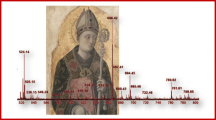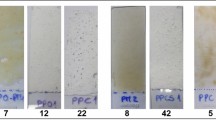Abstract
Enzyme-linked immunosorbent assay (ELISA) analysis of proteins offers a particularly promising approach for investigations in cultural heritage on account of its appreciated properties of being highly specific, sensitive, relatively fast, and cost-affordable with respect to other conventional techniques. In spite of that, it has never been fully exploited for routine analyses of painting materials in consideration of several analytical issues that inhibited its diffusion in conservation science: limited sample dimensions, decrease of binder solubility and reduced availability of antibody bonding sites occurring with protein degradation. In this study, an ELISA analytical protocol suited for the identification of aged denatured proteins in ancient painting micro-samples has been developed. We focused on the detection of bovine β-casein and chicken ovalbumin as markers of bovine milk (or casein) and chicken albumen, respectively. A systematic experimentation of the ELISA protocol has been carried out on mock-ups of mural and easel painting prepared with 13 different pigments to assess limits and strengths of the method when applied for the identification of proteins in presence of a predominant inorganic matrix. The analytical procedure has been optimized with respect to protein extraction, antibodies’ concentrations, incubation time and temperature; it allows the detection of the investigated proteins with sensitivity down to nanograms. The optimized protocol was then tested on artificially aged painting models. Analytical results were very encouraging and demonstrated that ELISA allows for protein analysis also in degraded painting samples. To address the feasibility of the developed ELISA methodology, we positively investigated real painting samples and results have been cross-validated by gas chromatography–mass spectrometry.







Similar content being viewed by others
References
Wilson K, Walker JM (1994) Principles and techniques of practical biochemistry, 4th edn. Cambridge University Press, Cambridge
Scott DA, Newman M, Schilling M, Derrick MR, Khanjian HP (1996) Archaeometry 38:695–705
Cattaneo C, Gelsthorpe K, Phillips P, Sokol RJ (1995) J Archaeol Sci 22:271–276
Kockaert L, Gausset P, Dubi-Rucquoy M (1989) Stud Conserv 34:183–188
Raminez-Barat B, de la Viña S (2001) Stud Conserv 46:282–288
Heginbotham A, Millay V, Quick M (2006) J Am Inst Cons 45:89–106
Vagnini M, Pitzurra L, Cartechini L, Miliani C, Brunetti BG, Sgamellotti A (2008) Anal Bioanal Chem 392:57–64
Cartechini L, Vagnini M, Palmieri M, Pitzurra L, Mello T, Mazurek J, Chiari G (2010) Acc Chem Res 43:867–876
Scott DA, Warmlandera S, Mazurek J, Quirkea S (2009) J Archaeol Sci 36:923–932
Mazurek J, Heginbotham A, Schilling M, Chiari G (2008) ICOM Committee Conserv 2:678–685
Dolci LS, Sciutto G, Guardigli M, Rizzoli M, Prati S, Mazzeo R, Roda A (2008) Anal Bioanal Chem 392:29–35
Cennini C (XIV sec.) (1982) Il Libro dell’Arte. Neri Pozza Ed., Vicenza
Mills JS, White R (1994) The organic chemistry of museum objects, 2nd edn. Butterworths-Heinemann, London
Colombini MP, Modugno F (2004) J Sep Sci 27:147–160
Leo G, Cartechini L, Pucci P, Sgamellotti A, Marino G, Birolo L (2009) Anal Bioanal Chem 395:2269–2280
Kuckova S, Hynek R, Kodicek M (2009) MALDI-MS applied to the analysis of protein paint binders. In: Colombini MP, Modugno F (eds) Organic mass spectrometry in art and archaeology, Chapter 6. Wiley, UK
Tokarski C, Martin E, Rolando C, Cren-Olivè C (2006) Anal Chem 78:1494–1502
Solazzo C, Fitzhugh WW, Rolando C, Tokarski C (2008) Anal Chem 80:4590–4597
Nelson DL, Cox MM (2000) Lehninger principles of biochemistry, 3rd edn. Worth, New York
Aguita G, Martin R, Garcia T, Morales P, Haza A, Gonzalez I, Sanz B, Hernandez PE (1995) J Dairy Res 62:655–659
Miliani C, Rosi F, Brunetti BG, Sgamellotti A (2010) Acc Chem Res 43:728–738
Vagnini M, Miliani C, Cartechini L, Rocchi P, Brunetti BG, Sgamellotti A (2009) Anal Bioanal Chem 395:2107–2118
Bonaduce I, Cito M, Colombini MP (2009) J Chromatogr A 1216:5931–5939
Lluveras A, Bonaduce I, Andreotti A, Colombini MP (2010) Anal Chem 82:376–386
Karpowicz A (1981) Stud Conserv 26:153–160
van Boekel MAJS (1999) Int Dairy J 9:237–241
Lai MC, Topp EM (1999) J Pharm Sci 88:489–500
Stadtman ER (2006) Free Radic Res 40:1250–1258
Garrison WM (1987) Chem Rev 87:381–398
Kato Y, Uchida K, Kawakishi S (1992) J Agric Food Chem 40:373–379
Grant KB, Kassai M (2006) Curr Org Chem 10:1035–1049
Boon JJ, Peulvé SL, van den Brink OF, Duursma MC, Rainford D (1997) In early Italian painting technique. In: Bakkenist T, Hoppenbrouwers R, Dubois H (eds) Limburg Conservation Institute: Maastricht, pp 32–47
van den Brink OF, Boon JJ, O’Connor PB, Duursma MC, Heeren RMA (2001) J Mass Spectrom 36:479–492
Miliani C, Rosi F, Borgia I, Benedetti P, Brunetti BG, Sgamellotti A (2007) Appl Spectrosc 61:293–299
Acknowledgments
Support from the European Commission through the project CHARISMA (FP7-Infrastructure-n. 228330) is gratefully acknowledged. Melissa Palmieri thanks the Regione dell’Umbria for a grant POR-FSE 2007-2013, Asse II, “Occupabilità”.
Author information
Authors and Affiliations
Corresponding author
Additional information
Published in the special issue Analytical Chemistry for Cultural Heritage with Guest Editors Rocco Mazzeo, Silvia Prati, and Aldo Roda.
Rights and permissions
About this article
Cite this article
Palmieri, M., Vagnini, M., Pitzurra, L. et al. Development of an analytical protocol for a fast, sensitive and specific protein recognition in paintings by enzyme-linked immunosorbent assay (ELISA). Anal Bioanal Chem 399, 3011–3023 (2011). https://doi.org/10.1007/s00216-010-4308-1
Received:
Revised:
Accepted:
Published:
Issue Date:
DOI: https://doi.org/10.1007/s00216-010-4308-1




